Photos and technical information courtesy of General Motors Corp.
The new Chevrolet Corvette LT1 engine, the first of the Gen 5 family of small block engines, combines several advanced technologies, including direct injection, active fuel management and continuously variable valve timing to support an advanced combustion system.
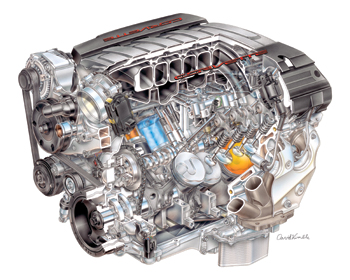 The Gen 5 small block — a technologically advanced 6.2L V8 that delivers an estimated 450 hp — helps power the 2014 Corvette to run 0-60 mph in less than four seconds.
The Gen 5 small block — a technologically advanced 6.2L V8 that delivers an estimated 450 hp — helps power the 2014 Corvette to run 0-60 mph in less than four seconds.
This engine also helps it be the most fuel-efficient Corvette ever, exceeding the 2013 EPA-estimated 26 miles per gallon (mpg) on the highway.
“The Holy Grail for developing a performance car is delivering greater performance and more power with greater fuel economy and that’s what we’ve achieved,” said Tadge Juechter, Corvette chief engineer. “By leveraging technology, we are able to get more out of every drop of gasoline and because of that, we expect the new Corvette will be the most fuel-efficient 450 horsepower car on the market.”
The Corvette LT1 represents the most significant redesign in the Small Block Chevy’s nearly 60-year history. The LT1 has been optimized to produce a broader power band. Below 4,000 rpm, the torque of the Corvette LT1 is comparable to that of the 7.0L LS7 out of the current Corvette Z06, according to GM officials.
It all began on June 30, 1953, when the first of a new kind of Chevrolet – indeed, a new kind of American car – rolled off an assembly line in Flint, MI.
The car had only two seats. There were no roll-up windows, or exterior door handles, for that matter. Its body wasn’t stamped from steel but, rather, molded from reinforced fiberglass.
While the postwar Baby Boom was in full swing, this was definitely not a family car. This was a very personal vehicle, one that promised a driver and a passenger all of the thrills of the open road.
Skeptics gave the car little chance of lasting beyond an initial run of a few dozen units. However, 60 years later the Chevrolet Corvette survives – and thrives – as an American automotive and cultural icon.
“Through the years, Corvette certainly offered state-of-the-art features, designs, technologies and performance,” said Juechter, “However, I think what has made the Corvette such an enduring concept is the exciting experience of driving one.
“No matter what your station in life, when you’re behind the wheel of a Corvette, you’re an Olympic athlete – able to go faster, stop quicker, and turn better than everyone else,” Juechter continued. “Very few cars can match that experience. And no other car has delivered that experience as well, or to more people, than the Corvette.”
Powerplants in the Corvette’s Lifeline
Interestingly, the Corvette wasn’t born with a V-8 between its front wheels. It arrived in the fledging sports car’s third model year, 1955, where it was an option selected by 90% of customers. That first 4.3L (265 cu.in.) engine produced 195 hp (145 kW) with a four-barrel carburetor. The new Gen 5 LT1 – the third small block to carry the moniker – displaces 6.2L (376 cu.in.) and delivers an estimated 450 hp (335 kW).
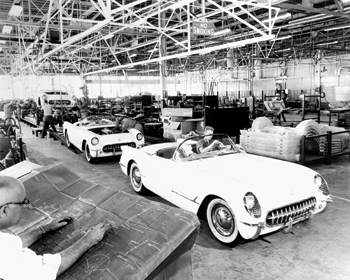 The small block V-8 engine was physically smaller, 50 lbs. lighter and more powerful than the “Blue Flame” inline-six engine it replaced in the 1955 Corvette. Its 4.4-inch bore centers —the distance from the center of one cylinder to the next — would come to symbolize the compact, balanced performance of the engine’s architecture. Every generation of the small block – including the forthcoming Gen 5 — features 4.4-inch bore centers.
The small block V-8 engine was physically smaller, 50 lbs. lighter and more powerful than the “Blue Flame” inline-six engine it replaced in the 1955 Corvette. Its 4.4-inch bore centers —the distance from the center of one cylinder to the next — would come to symbolize the compact, balanced performance of the engine’s architecture. Every generation of the small block – including the forthcoming Gen 5 — features 4.4-inch bore centers.
After only two years on the market, the Small Block began a steady march upward in displacement, power and technological advancement. In 1957, a version equipped with mechanical fuel injection was introduced, dubbed Ramjet. The only other high-volume manufacturer to offer fuel injection at the time was Mercedes-Benz.
Mechanical fuel injection was discontinued in the mid-60s, but the small block introduced electronically controlled fuel injection in the 1980s on the Corvette and established a benchmark with the 1985 launch of Tuned Port Injection on the C4 generation Corvette. This electronically controlled port fuel injection system was advanced in its day and its basic design is still used on most passenger cars and light-duty trucks more than a quarter-century later.
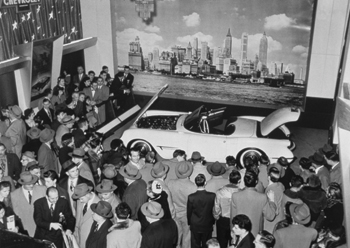 The introduction of the Gen 3 small block with the 1997 launch of the C5 Corvette ushered in a new era of technologically advanced performance. It was a clean-sheet redesign of the architecture — retaining, of course, the 4.4-inch bore centers and cam-in-block foundation — with features including an aluminum, long-skirt cylinder block with six main cap fasteners, high-flow cylinder heads that improved high-rpm horsepower and a lightweight composite intake manifold.
The introduction of the Gen 3 small block with the 1997 launch of the C5 Corvette ushered in a new era of technologically advanced performance. It was a clean-sheet redesign of the architecture — retaining, of course, the 4.4-inch bore centers and cam-in-block foundation — with features including an aluminum, long-skirt cylinder block with six main cap fasteners, high-flow cylinder heads that improved high-rpm horsepower and a lightweight composite intake manifold.
As the C6 Corvette enters its final year, it sends off the Gen 4 small block with a couple of notable distinctions: The 7.0L LS7 engine that powers the Corvette Z06 is the largest-displacement production small block ever, while the 638-hp 6.2L supercharged LS9 engine in the Corvette ZR1 is the most powerful production small block ever, helping power the car to a 205-mph top speed.
——————————————————————————————————————————————–
From ‘Show to Go’
Corvette was first created under the code-name XP-122 to provide Americans with a glimpse of a European-style sports car designed for this side of the Atlantic. It was one of several concept cars unveiled in January, 1953 at the GM Motorama show in the ballroom of the Waldorf Astoria Hotel in New York City.
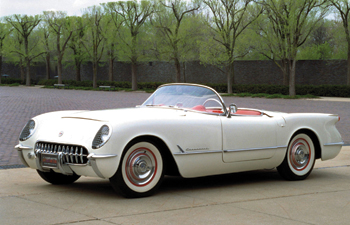 Initial plans called for about 150 Corvettes, primarily to help draw potential customers into Chevrolet dealerships scattered across the U.S.’s then-48 states. Overwhelming demand doubled the first-year production to 300 units. The following year, the Corvette moved to a GM assembly facility in St. Louis, Mo., where 3,640 Corvettes were built for the 1954 model year.
Initial plans called for about 150 Corvettes, primarily to help draw potential customers into Chevrolet dealerships scattered across the U.S.’s then-48 states. Overwhelming demand doubled the first-year production to 300 units. The following year, the Corvette moved to a GM assembly facility in St. Louis, Mo., where 3,640 Corvettes were built for the 1954 model year.
Those first Corvettes sparked Americans’ 60-year love affair with the Corvette. Since 1953, more than 1.5 million Corvettes have been built. These cars have become synonymous with American performance — from cruising down Americana on Route 66, to taking the checkered flag at the world’s most prestigious road race, the 24 Hours of Le Mans.
——————————————————————————————————————————————–
LT1 Legacy
The first LT-1 (with a hyphen) engine was introduced in the Corvette in 1970 as an option. It was a raucous, racing-inspired engine with solid valve lifters, a high-lift camshaft and high-winding personality that redefined small block performance. Displacing 350 cubic inches (5.7L), with a compression ratio of 11:1, it was rated at 370 hp at 6,000 rpm and 380 lb.-ft. of torque at 4,000 rpm. It was enough to push the Corvette from 0 to 60 mph in less than six seconds.
Indeed, the LT-1 was a true high-performance powerhouse, featuring many heavy-duty components not found on the Corvette’s standard 350 engine, including a stronger cylinder block with four-bolt main caps, forged aluminum pistons, a high-rise aluminum intake manifold, a baffled oil pan for reduced windage, a transistorized ignition system and high-volume oil and fuel pumps.
Only 1,287 Corvette’s left the factory in 1970 with the LT-1 engine. It remained in production for another couple of years, but lower compression ratios and other regulation-conforming changes resulted in lower horsepower.
The LT1 (no hyphen) returned to the Corvette in 1992, launching the five-year lifespan of the Gen 2 small block. It’s built on the successful design of the L98-code Gen I small block that debuted in the 1985, featuring the port fuel injection design that most automotive engines still use today. Like the original LT-1, the Gen 2 version displaced 350 cu.in. and featured a four-bolt-main block.
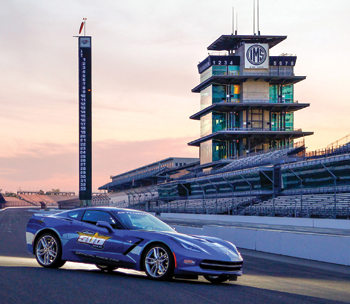 The Gen 2 LT1’s most significant update over the Gen I small block was a reverse-flow cooling system, which cooled the cylinder heads first to achieve lower cylinder temperatures. (http://bit.ly/12lVel8) That allowed a higher, 10.4:1 compression ratio that helped achieve greater power: 300 hp at 5,000 rpm and 330 lb.-ft. of torque at 4,000 rpm. It helped the Corvette achieve 0-60 acceleration comparable to the 1970 model, while also helping propel the 1992 model to a top speed of more than 160 mph.
The Gen 2 LT1’s most significant update over the Gen I small block was a reverse-flow cooling system, which cooled the cylinder heads first to achieve lower cylinder temperatures. (http://bit.ly/12lVel8) That allowed a higher, 10.4:1 compression ratio that helped achieve greater power: 300 hp at 5,000 rpm and 330 lb.-ft. of torque at 4,000 rpm. It helped the Corvette achieve 0-60 acceleration comparable to the 1970 model, while also helping propel the 1992 model to a top speed of more than 160 mph.
To mark the final year for the C4 Corvette generation and the final year for the Gen 2 small block, a pair of special-edition models was offered in 1996 with a higher-power version of the engine, dubbed LT4. It was rated at 330 horsepower and is easily identified by its red cast-aluminum intake manifold.
After an 18-year hiatus, the LT1 returned to the Corvette for 2014, matching an all-new car with the all-new Gen 5 engine. With a preliminary output of 450 hp (335 kW), the new LT1 builds on a heritage of high-winding, power-dense small blocks that have become high-performance legends.
Read more about the technological advances on the 2014 Chevrolet Corvette LT1 engine at: http://bit.ly/12YZNAe.
——————————————————————————————————————————————–
Corvette and Small Block Performance Milestones
• 1955: 265-cid V-8 debuts in the Corvette as an option, with 195 hp. Ninety percent of customers select it.
• 1957: 283-cid V8 introduced; Rochester mechanical fuel injection helps the small block produce 283 hp — or one horsepower for every cubic inch. 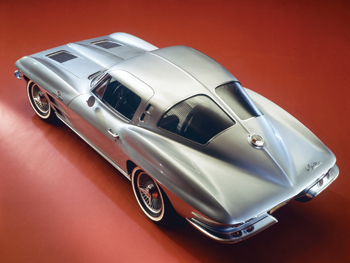
• 1959: William Mitchell, vice-president of GM styling, races the original Stingray Corvette racing car concept, which features a 315-hp version of the fuel-injected 283 small block.
• 1964: 327-cid Small Block is rated at 375 horsepower with Rochester fuel injection; the first Holley four-barrel carburetor is used on a production small block engine. 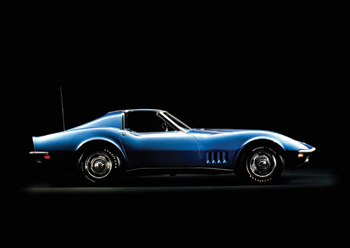
• 1969: The 350-cid small block is introduced in the Corvette. The standard engine is rated at 300 hp and an available “L46” version is rated at 350 hp.
• 1970: The first LT-1 debuts in Corvette, rated at 370 hp and 380 lb.-ft. of torque.
• 1972: Final year for the Gen 1 LT-1.
• 1982: Cross Fire electronic fuel injection introduced, featuring a pair of diagonally opposed throttle bodies feeding a 350 engine and rated at 200 hp.
• 1985: Tuned Port Injection introduced on the Corvette, ushering in the modern age of port fuel injection and increasing the Corvette’s horsepower rating to 230. 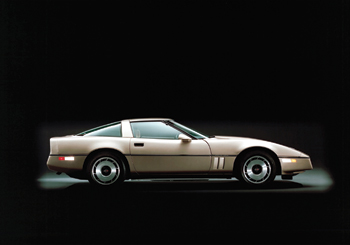
• 1986: Aluminum cylinder heads introduced mid-year on the Corvette.
• 1987: Hydraulic roller lifters introduced on the “L98” Tuned Port Injection engine, reducing friction for greater efficiency and performance – the Corvette’s output jumps to 240 hp.
• 1992: Gen 2 LT1 introduced in the Corvette, featuring a reverse-flow cooling system, all-new cylinder heads and computer-controlled ignition timing, pushing horsepower to 300 – a 20% jump over the ’91 Corvette’s L98 engine.
• 1996: The high-output LT4, with 330 hp in limited-edition Corvette models, is the finale for the Gen 2 engine.
• 1997: New Gen 3 Small Block debuts in the all-new C5 Corvette, carrying the LS1 name and features an all-aluminum construction, deep-skirt block and 350 hp. 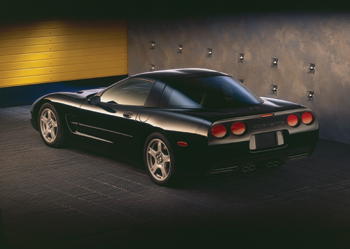
• 2001: Higher-performance LS6 engine with 385 hp powers the new, track-oriented Corvette Z06. Horsepower increases to 405 in 2002.
• 2005: The Corvette’s new, 6.0L LS2 engine with 400 hp introduces the Gen 4 Small Block.
• 2006: Racing-inspired 7.0L LS7 engine debuts in the Corvette Z06 with 505 hp and features forged titanium connecting rods, high-flow cylinder heads, titanium intake valves, dry-sump oiling system and more.
• 2008: The 6.2L Small Block debuts on the Corvette with 430 horsepower.
• 2009: New Corvette ZR1 receives a 638-hp, supercharged LS9 small block – the most powerful production-car engine ever built by GM and enabling a 205 mph top speed. 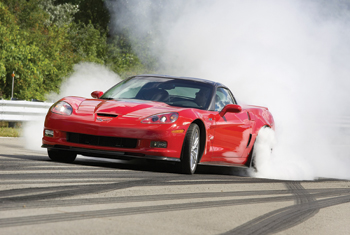
• 2011: GM builds its 100 millionth small block on Nov. 29. It is an LS9 engine built at the Performance Build Center, in Wixom, MI.
• 2012: Final year for the Gen 4 engine in the Corvette.
• 2013: New LT1 Gen 5 Small Block debuts in the seventh-generation, 2014 Corvette with preliminary output of 450 hp (335 kW) – 231% more power from only 42% larger displacement. It is the most significant redesign in the small block’s nearly 60-year history.












